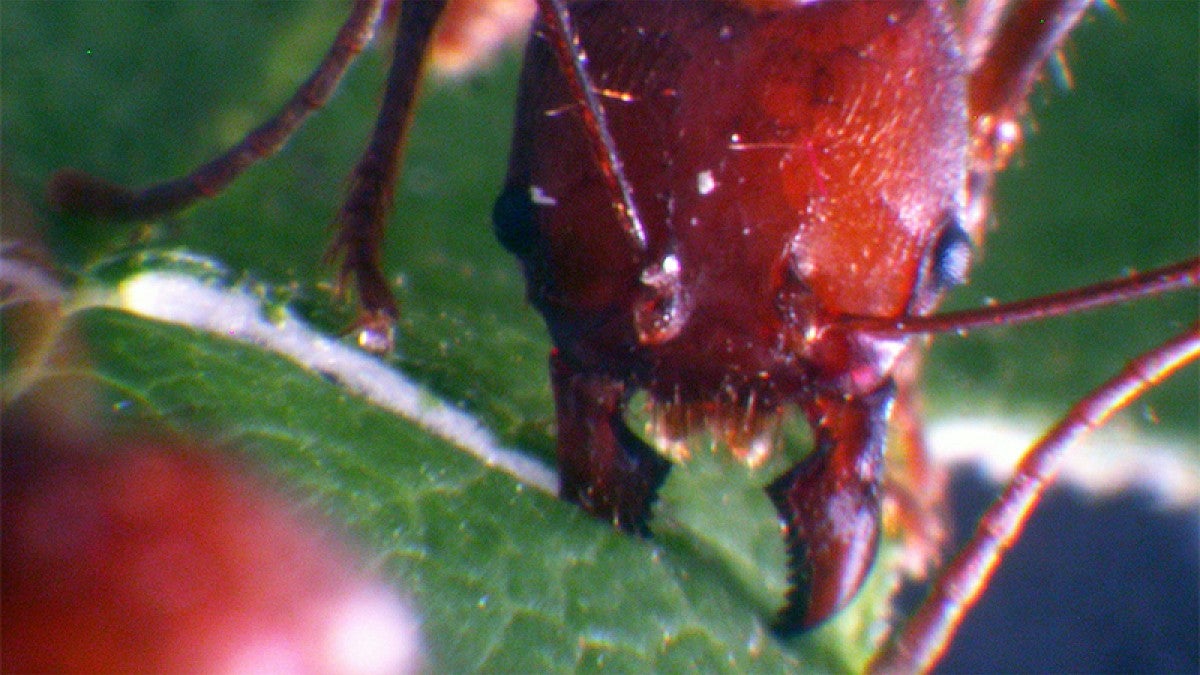Ant mandibles, spider fangs and scorpion sting tips are made of special materials that deliver sharpness for penetrating prey that the limited forces of their small muscles won’t otherwise allow, according to new University of Oregon research.
That knowledge won’t ease the pain of puncture in human skin, but it may be useful for designing new precision cutting tools, said Robert Schofield, lead author of a paper published this week in the Nature journal Scientific Reports.
Schofield’s team, which included 15 current and former undergraduate and graduate students from the UO and Lane Community College, used miniature testing machines to explore the sharp tools of such small organisms as ants, bristle worms, scorpions and spiders. In all, the team completed 1,500 hand-positioned measurements on 150 organisms from 10 different species.
The sharp tools contain heavy element biomaterials, as the research team labeled them. They are enriched with zinc and manganese.
“Using atom probe tomography, an advanced type of microscope, we observed the distribution of zinc and proteins in ant teeth at subnanometer scale, which helped us understand why these cutting ‘tools’ are so strong,” said Arun Devaraj, a materials scientist who applied the specialized atomic probe tomography techniques developed at Pacific Northwest National Laboratory.
They also represent a third class of structural biomaterials, different than the plain organic materials found in claws and fingernails and mineralized substances in teeth and bones, the researchers concluded.
“We found that, if these small organisms made their tools of the same organic material as other stiff parts of their exoskeletons, the sharp edges would deform more, they would not be as hard, and they would often wear away much faster,” said Schofield, a researcher in the Department of Physics.
“On the other hand,” he said, “if they used the calcified material that human teeth are made from, their tools would be hard enough, but they wouldn’t be sharp enough because of the large crystal size.”
This class of biomaterials, Schofield said, create sharper, damage-resistant tools that allow scorpions, for example, to use about a fifth of the force relative to that for plain organic materials.
With their testing machines and related techniques, Schofield’s team measured the ability of the organisms’ puncturing tools to resist impact and fracture. Also gathered were measurements on the abrasion resistance and damping, or mechanical energy, properties of the materials.
With atom probe tomography, the team created 3D maps of the molecular fragments in the protein structures, achieving a resolution of better than seven nanometers. Other precision instruments were used to disassemble the materials almost atom by atom to study their composition.
“Human engineers might learn from this biological trick used by small organisms in developing their sharp fangs, stings and mandibles,” he said. “The hardness of ant teeth, for example, increases from about the hardness of plastic to that of aluminum when zinc is added. While there are much harder engineering materials, they are often more brittle or ductile.”
The research, funded by the National Science Foundation, began under a grant issued in 2014, but the project was delayed by Schofield’s role on the UO team involved in the Laser Interferometer Gravitational Wave Observatory.
Schofield was tweaking the tools of the observatory’s Louisiana site on the morning in 2016 when the first gravitational wave was observed. Subsequently, he was involved in other adjustments and updates in the detection equipment in Washington and Louisiana.
Additional co-authors on the paper were Devaraj and X. Wang, both of the Pacific Northwest National Laboratory, and M.H. Nesson of Oregon State University’s Department of Biochemistry and Biophysics.
Technologies used in the project are located in the Center for Advanced Materials Characterization in Oregon, a UO-based facility known as CAMCOR, and the Environmental Molecular Sciences Laboratory at the Pacific Northwest National Laboratory in Richland, Washington.
—By Jim Barlow, University Communications


